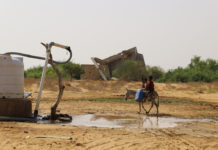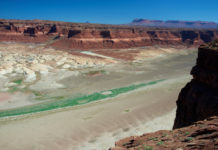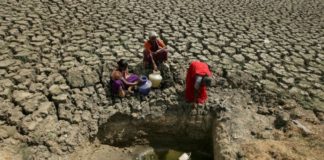What is an aquifer? An aquifer is an underground layer of water-bearing rock. At the top of the aquifer is the water table where much of the world’s water supplies come from. Rains and snows drain into the ground and fill the aquifer then they are extracted through springs and wells.
Read: Aquifers and Groundwater

Much of the world’s freshwater drinking supply comes from these aquifers. Globally, around 30% of our freshwater drinking supplies come from aquifers but in specific locations, it is much more than that. For example, in Florida, 90% of the state’s fresh drinking water comes from aquifer groundwaters. In Texas, the number is 60%.

In 2015 Water Resources Research published its findings regarding the state of the world’s groundwater in aquifers. The study utilized satellite imagery to study the effects of the world’s overuse of the planet’s aquifers. The findings were frightening.

- Among the 37 largest aquifers throughout the world, 13 of them were being depleted with little to no recharging.
- Eight of the aquifers were classified as overstressed with nearly no natural replenishment while another five were classified as stressed or highly stressed – this meant they were being depleted but there was at least some level of water flowing back into them.
The Arabian Aquifer System, the most overstressed aquifer in the world is the source of water for more than 60 million people. Second to this us the Indus Basin Aquifer located in northwestern India and Pakistan. Third, is the Murzuk-Djado Basin in North Africa.

These three aquifer systems represent the most overstressed aquifer systems in the world and the primary water resource for increasingly strained and desperate populations numbering in the hundreds of millions to billions.
When aquifers run low or dry, rivers, lakes and other freshwater resources begin to dry up and the land accustomed to agricultural production ceases to be fruitful.
When many of us think of the world’s supply of fresh water we likely think of rivers and lakes, but historically there have been hundreds of times more freshwater below the surface of the earth within these aquifers. Throughout history, mankind has drawn from aquifers to supply its water needs.

The drilling of wells and the pumping of water to the earth’s surface is essentially the technology of drawing upon the aquifers to provide humanity’s needs. As human civilization has grown, and cities became more densely populated, the need for that groundwater increased and as a result, the aquifers are shrinking today.
This would not be a problem if the water taken from the aquifers was being replaced, but increasingly we are learning that we are taking the water faster than it can be replaced. This is specifically what the alarming report illustrated in the satellite imagery from NASA revealed in 2015.







